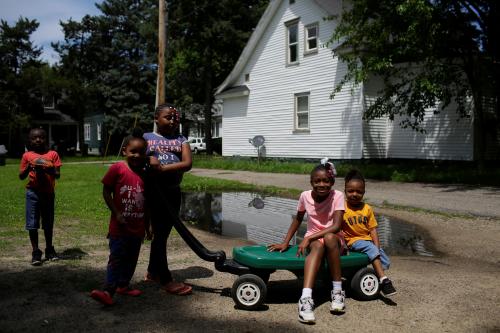The expanded child tax credit proposed under the Biden American Rescue Plan is the largest single anti-poverty investment in children since the introduction of Head Start to over half a million families in the summer of 1965. With Black, Native American, and Latinx children representing nearly three-quarters of children in poverty as of 2019, scholars and policy pundits are simultaneously touting the expanded child tax credit as a policy of racial equity. Reducing poverty through these new policy investments will go a long way: Evidence points to how income-based policies that reduce poverty may cushion against the blows of pandemic-induced income loss, protect children from further harm, and support their development. Relief from continued stimulus payments and the expanded child tax credit will also more generally alleviate the negative ripple effects of economic and health distress on family life and parenting. However, these policy investments in isolation may not reach their full impact without also addressing the long-standing racial disparities of structural racism—some of which contributed to child poverty in the first place.
Without direct policies to address segregation, racism, and white supremacy, Black parents may continue to be excluded from the financial, labor, and real estate markets; many Latinx parents will continue to fear engaging with government and public systems; and racial segregation in housing and neighborhoods will likely continue to contribute to uneven and lower quality investments in Black and Brown children’s education. By hailing contemporaneous policy investments in economic well-being as a dual solution for racial equity and poverty, we risk perpetuating ongoing policy blind spots. How can well-intentioned anti-poverty policies of today succeed in leveling the playing field across racial and economic lines?
Addressing structural racism that contributes to child poverty
Reflecting on why so many Black, Latinx, and Indigenous children are income poor can be a useful starting place. The reasons encompass not just factors that affect distributional inequality, but those that affect relational inequality—the historic and systematic efforts that exclude certain social groups due to racism and xenophobia. Income-based efforts to reduce distributional economic inequality do little to address the roots of relational inequality–including racialized political stereotypes that have affected government investment (e.g., the welfare queen from Ronald Reagan’s presidency); to geographic and residentially patterned exclusion from opportunities for social mobility and political representation (e.g., voting rights restrictions and gerrymandering); to large variation in state safety nets and spending on children; to a range of discriminatory policies that have impeded accumulation of Black economic wealth.
The success of even the most celebrated policy innovations, including the Earned Income Tax Credit, will only be as effective as policies that also address racially patterned access to secure earnings, financial credit, and housing.
Investments in public infrastructure represent one step toward meeting the goals of racial equity: Reliable roads and public transportation, consistent and low-cost high-bandwidth internet, and a cleaner environment are each components of a healthy start for children in the U.S. Recent proposals included in the American Families Plan–particularly with respect to paid family leave and early care and education—will similarly help meet these goals. However, to deliver on the promise of equitable economic opportunity for all children, policies must seek to redress inequities and racism in these four key areas:
- Beyond issues of police brutality and the need for policy reform, racism in the criminal justice system impacts youth and young adults in two ways that poverty reduction strategies alone will not solve. Black children, especially boys, are targeted for behavioral and related disciplinary problems as early as preschool. This targeting continues through older ages and contributes to high rates of suspensions or expulsions that result in pipelines to the juvenile justice system. Second, mass incarceration among Black and Latinx fathers has displaced sources of social and economic support for thousands of children, and worse, having a criminal record, sometimes due to minor infractions, remains a barrier for parents to secure a job. Reducing prosecution of nonviolent misdemeanors can decrease subsequent criminal activity and will not interfere with job prospects. Deploying restorative justice interventions and similar economic and mental health supports in schools (in lieu of zero-tolerance and related harsher disciplinary strategies) are pathways toward racial equity in school success.
- Failed historical policies of public housing and concentrated poverty have given way to vouchers and mixed-income housing but limited success toward neighborhood and educational racial integration. Forward-thinking racially equitable housing policies must consider zoning reform and paths toward home ownership that have historically excluded Black and Brown families. Examples here include customized approaches to address barriers to moving to better neighborhoods and zoning reforms that would increase the number of units on lots like the one recently passed in Portland, Oregon.
- Segregation in public schools has followed lockstep with housing and neighborhood segregation and has interrupted educational achievement and completion all the way through postsecondary education. Reallocation of federal student aid to states and school districts based on poverty rates (and not only population numbers) can help. Supporting educational equity can also be achieved through continual experimentation of school integration models such as that deployed in Hartford and other school districts through offering publicly funded options for students to enroll in magnet schools or schools in nearby school districts.
- Uneven access to preventive, curative and diagnostic health care has contributed to unequitable medical treatment of people of color, despite the high coverage rates of insurance via Medicaid among income-eligible children of all groups. The delivery of the most basic of medical care at childbirth is called into question given higher rates of mortality among Black infants irrespective of family income. Although rates of children without health insurance declined through most of the 2010s, uninsured rates have recently increased among Latinx children, especially among those with a foreign born parent.
Policies aimed at supporting minimum levels of basic income—and further, income-based supplements to earnings—will go a long way toward reducing child poverty. However, these policies alone will not address the structural racism that has contributed to families’ lower earnings, income, wealth, or lower quality health care or education. Optimism prior to the pandemic about the potential to reduce child poverty by half hinged on policy recommendations that did not directly address long-standing disparities by race and ethnic group, and further, by citizenship status of family members—the very factors that exclude many children from benefiting fully. Even the most celebrated policy innovations, including the Earned Income Tax Credit, will only be as effective as policies that also address racially patterned access to secure earnings, financial credit, and housing. Policies to fight child poverty must also prioritize the dismantling of structural racism and bias that underlie the need for investment in the first place. Economic and anti-racist reforms in criminal justice, housing, education, and health care are each promising steps in that direction.








Commentary
Anti-poverty policies for children must level the playing field across both racial and economic lines
May 18, 2021